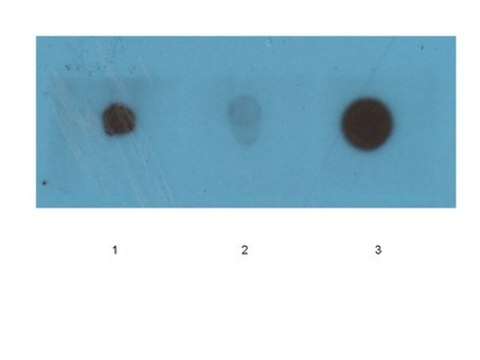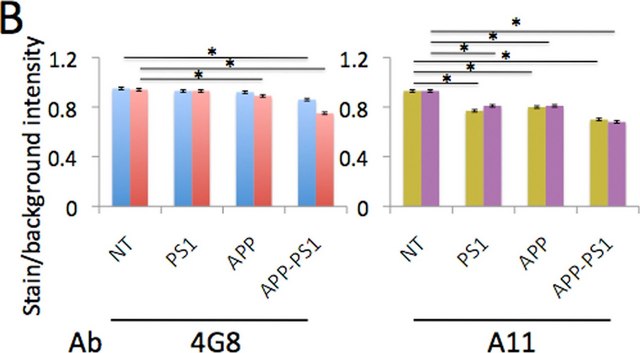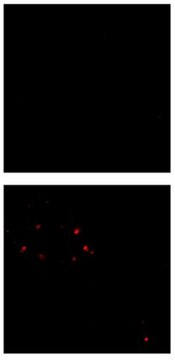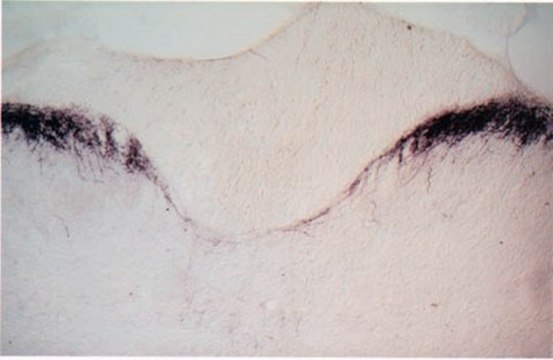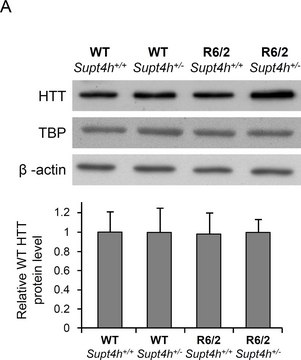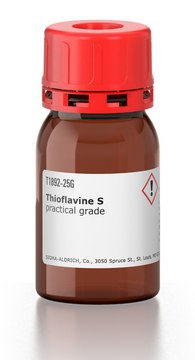推荐产品
生物来源
rabbit
质量水平
抗体形式
serum
抗体产品类型
primary antibodies
克隆
polyclonal
种属反应性
human
种属反应性(根据同源性预测)
mouse, rat
制造商/商品名称
Chemicon®
技术
ELISA: suitable
dot blot: suitable
immunocytochemistry: suitable
immunohistochemistry: suitable
immunoprecipitation (IP): suitable
western blot: suitable
同位素/亚型
IgG
UniProt登记号
运输
wet ice
靶向翻译后修饰
unmodified
基因信息
human ... APP(351)
mouse ... App(11820)
一般描述
Amyloid monomeric proteins can sometimes oligomerize into destructive amyloid fibrils. Amyloidogenic conformations of non-disease related proteins can be created by partial protein misfolding or denaturation. In disease state oligomerization, extensive amyloid oligomerization creates plaques in neural tissue that correlates with Alzheimer’s symptomology.
特异性
This antibody recognizes generic epitopes common to many amyloid fibrils and fibrillar oligomers, but not monomers, prefibrillar oligomers or natively folded proteins.
免疫原
Fibrils prepared from human islet amyloid polypeptide.
应用
Dot Blot Analysis: 1:1,000 dilution of this antibody detected Amyloid fibrils in fibrils and monomers but not in prefibril oligos. A 1:5,000 dilution, as cited in Glabe C., et al. (2007) Mol Neurodegener 2, 18 shows that the binding with monomers is likely non-specific, and is a possible result of high primary antibody concentration.
This Anti-Amyloid Fibrils LOC Antibody is validated for use in IP, IC, IH, ELISA, WB, DB for the detection of Amyloid Fibrils LOC.
质量
Evaluated by Dot Blot in monomers, prefibril oligos, and fibrils.
Dot Blot Analysis: 1:1,000 dilution of this antibody detected Amyloid fibrils in fibrils and monomers but not in prefibril oligos. A 1:5,000 dilution, as cited in Glabe C., et al. (2007) Mol Neurodegener 2, 18 shows that the binding with monomers is likely non-specific, and is a possible result of high primary antibody concentration.
Dot Blot Analysis: 1:1,000 dilution of this antibody detected Amyloid fibrils in fibrils and monomers but not in prefibril oligos. A 1:5,000 dilution, as cited in Glabe C., et al. (2007) Mol Neurodegener 2, 18 shows that the binding with monomers is likely non-specific, and is a possible result of high primary antibody concentration.
储存及稳定性
Stable for 1 year at -20°C from date of receipt.
Handling Recommendations: Upon receipt and prior to removing the cap, centrifuge the vial and gently mix the solution. Aliquot into microcentrifuge tubes and store at -20°C. Avoid repeated freeze/thaw cycles, which may damage IgG and affect product performance. After thawing, store at 4°C in 0.02% sodium azide.
Handling Recommendations: Upon receipt and prior to removing the cap, centrifuge the vial and gently mix the solution. Aliquot into microcentrifuge tubes and store at -20°C. Avoid repeated freeze/thaw cycles, which may damage IgG and affect product performance. After thawing, store at 4°C in 0.02% sodium azide.
法律信息
CHEMICON is a registered trademark of Merck KGaA, Darmstadt, Germany
未找到合适的产品?
试试我们的产品选型工具.
储存分类代码
10 - Combustible liquids
WGK
WGK 1
Juan Jose Ramos-Rodriguez et al.
Molecular neurobiology, 54(5), 3428-3438 (2016-05-15)
Age remains the main risk factor for developing Alzheimer's disease (AD) although certain metabolic alterations, including prediabetes and type 2 diabetes (T2D), may also increase this risk. In order to understand this relationship, we have studied an AD-prediabetes mouse model
Neuroinflammation and related neuropathologies in APPSL mice: further value of this in vivo model of Alzheimer's disease.
Loffler, T; Flunkert, S; Havas, D; Schweinzer, C; Uger, M; Windisch, M; Steyrer, E; Hutter-Paier, B
Journal of Neuroinflammation null
Thomas Filip et al.
Alzheimer's research & therapy, 13(1), 175-175 (2021-10-18)
To better understand the etiology and pathomechanisms of Alzheimer's disease, several transgenic animal models that overexpress human tau or human amyloid-beta (Aβ) have been developed. In the present study, we generated a novel transgenic rat model by cross-breeding amyloid precursor
Elin K Esbjörner et al.
Chemistry & biology, 21(6), 732-742 (2014-05-27)
Insight into how amyloid β (Aβ) aggregation occurs in vivo is vital for understanding the molecular pathways that underlie Alzheimer's disease and requires new techniques that provide detailed kinetic and mechanistic information. Using noninvasive fluorescence lifetime recordings, we imaged the formation
Sahil Chandhok et al.
Scientific reports, 13(1), 14471-14471 (2023-09-03)
The formation of protein aggregates is a hallmark of many neurodegenerative diseases and systemic amyloidoses. These disorders are associated with the fibrillation of a variety of proteins/peptides, which ultimately leads to cell toxicity and tissue damage. Understanding how amyloid aggregation
我们的科学家团队拥有各种研究领域经验,包括生命科学、材料科学、化学合成、色谱、分析及许多其他领域.
联系技术服务部门